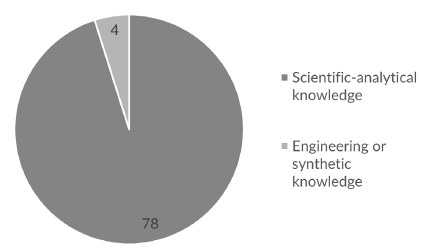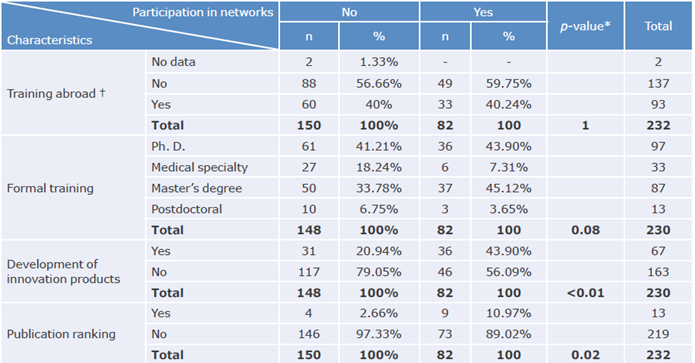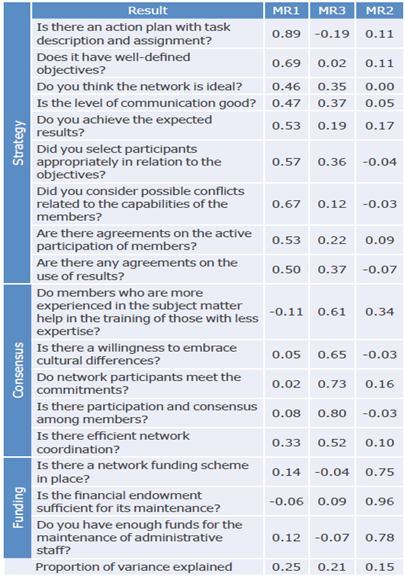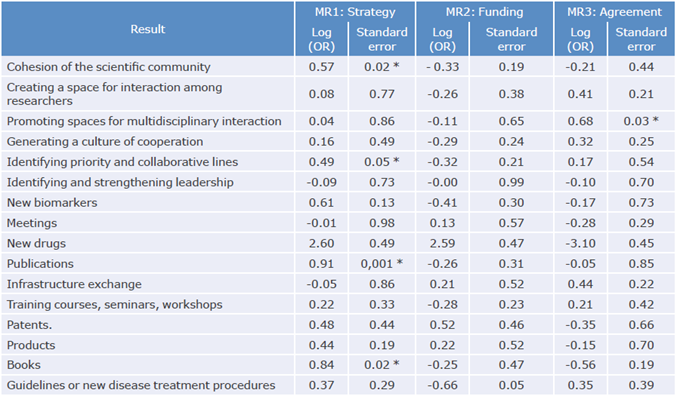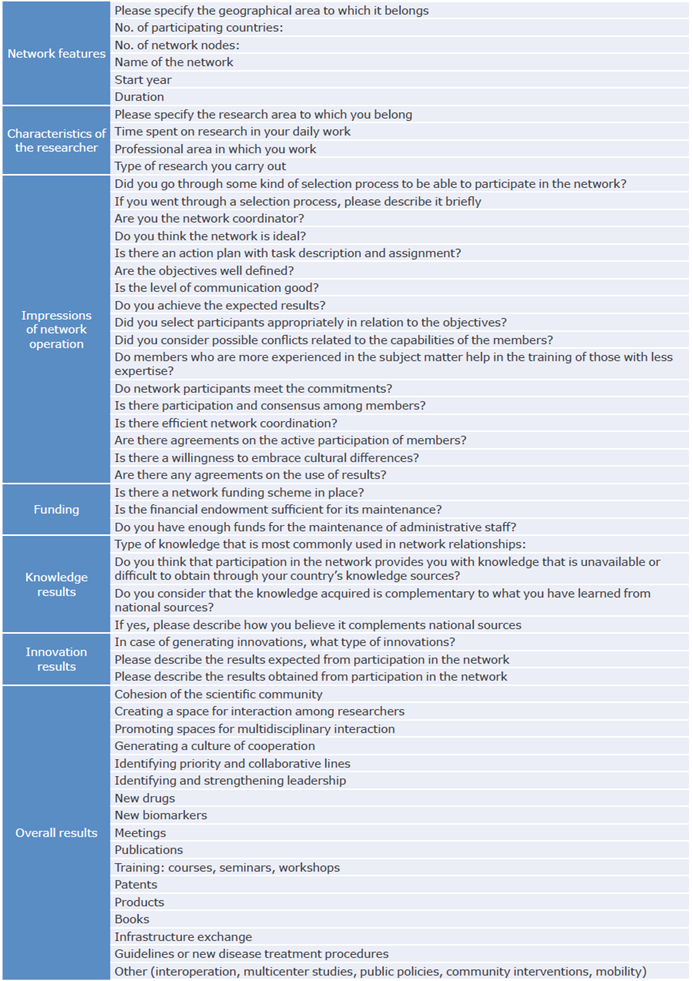Introduction
At present, knowledge is the basis for the growth of countries because its accumulation determines their capacity for innovation.1 Therefore, boosting knowledge through national innovation systems is critical to every nation's economic progress.2-5
In this sense, Colombia, whose economic growth depended on the commercialization of raw commodities in the past, must now consider shifting the focus of production toward knowledge generation and innovation,6 both of which are critical determinants for the development of lagging economies. Research and innovation networks can be useful tools to achieve this goal; however, their effectiveness must be measured in order to establish the factors that facilitate knowledge generation and make it possible to share it among scientists.7
In the present study, network refers to a group of researchers or research groups (entities) created based on the structure proposed by the Colombian Ministry of Sciences (Minciencias, formerly Colciencias) and consisting of four types of individuals: researchers, researchers in training, undergraduate students, and associated members. Also, a node is understood as a group of research groups; each of these nodes can be from the same country or from several countries, but most belong to international networks.
To understand the conventional dynamics of the networks, the present study looked in the literature for classic points of view on the form and operation of networks8-11 and also incorporated some additional perspectives.
Proximity
As mentioned above, a research network is the set of entities (people, institutions, teams, etc.) that are connected to each other to facilitate material and intangible interactions among its members. In this way, each member has information on who knows what, how, where and when by analyzing shared knowledge and experiences.12 This allows knowledge to flow and research findings to improve.
At first glance, the ubiquity of research networks should ensure that outcomes are not influenced; however, it should be noted that innovation activities may be conditioned by processes spurred by geographic, social, and cultural proximity factors in collaborative contexts.13 In this regard, Marshall14, in his treatise on economics, emphasizes the necessity of physical proximity for the exchange of valuable knowledge in the production of economic resources.
Direct interaction or, in other words, face-to-face interaction, builds confidence; therefore, good coordination, in which physical meetings are encouraged, fosters collaboration and therefore productivity in a research network.15 However, some researchers claim that networks based solely on confidence would not be as operational as may be expected based on their findings.16,17 In this regard, Granovetter18 argues that relationships in networks are influenced by strong and weak ties of professional collaboration.
Thus, given the importance of physical proximity, the mobility of researchers could be an enhancer of the interactions mentioned above in open knowledge environments.19 Consequently, the present study aims to delve into the operation and results of research networks based on the capabilities acquired through research.
In order to evaluate the aforementioned capacities, the present research studies what has been called cognitive proximity, which refers to the exchange of knowledge acquired in the networks to the economic or social environment of the researcher. On the other hand, from a country perspective, knowledge absorptive capacity is usually measured using different indicators, such as the degree of digitization, the level of knowledge of the researchers, gross domestic expenditure on R&D (GERD), or patents (discarded in the present study because of its little relevance in Colombia).20
Information is generated in a network, which in turn allows for innovation; moreover, it produces what is known as creative destruction,21 a process in which obsolete schemes are replaced by new ones that derive precisely from innovation. It is important to note that for these innovations to be rooted at the social or economic level, knowledge absorptive capacity is necessary, and their superior value and fit in the demands of the country must be validated before they are made public.
Structure and operation
The "science of complexity" is one of the focal points for the study of networks in general. It emerges from basic sciences, comprises many areas of study -such as network science-, and allows to extrapolate its scientific findings for use in interdisciplinary research in fields as diverse as biology, computer science, etc.22
Another approach to research collaboration is known as "team science", which studies the interactions of scientific teams from a functional perspective utilizing useful day-to-day operating tools.23 In this regard, the advantages of information and communication technologies (ICTs)24 in remote collaboration should be highlighted, as they allow for the fluid and automatic distribution of information between research nodes, which, in turn, allows them to share knowledge and experiences. At this point, it is important to stress the relevance of the coordinator, who must keep the network active by providing and receiving knowledge through ICTs.25
On the other hand, it is essential to bear in mind that networks may have problems in their operation, which can result from social, economic, or academic interaction, and even from disagreements or incompatibilities among participants.26
Network results
The determinants of network success may be in conflict because of the subjectivity of researchers and the fact that there are sometimes very diverse opinions among them that are far removed from reality.27
Contrary to what is expected, the use of ICTs may not reduce costs or increase network productivity due to the lack of these tools in developing regions.28 In this regard, Uribe-Zirene & Cuadros-Mejía29 state that some of the difficulties encountered in the networks are associated with the lack of funding for projects and activities, lack of time to implement activities, problems of communication and coordination, and access to ICTs.
Similarly, Hagedoorn et al.,30 in an article summarizing academic, professional and policy literature on research partnerships focused on technology policy, found that there are a variety of important reasons why firms participate in research associations and a number of reasons why governments encourage them. The authors concluded that technology policy authorities should be aware of these reasons and, therefore, be cautious when comparing the benefits and downside effects associated with collaboration.
On the other hand, Borondo et al.31 state that the interactions between nodes according to their position in the network is decisive for obtaining results if a meritocratic model is followed (if the compensation and power available to individuals are determined by their abilities and merits) or a topocratic one (if the compensation and power available to an individual is primarily determined by their position in the network). Thus, the structure of the networks represents a fundamental constraint as a perfectly meritocratic model for fully connected networks becomes topocratic for sparse networks, such as those of society.
Given this scenario, the objective of this study was to analyze the activity of Colombian researchers in the area of medical and health sciences in research networks, as well as its characteristics and the factors associated with greater participation in these networks and better results in areas of research and innovation. This study also describes the academic profile of the researchers and demonstrates how physical and cognitive proximity generate confidence in research networks, as they impact knowledge absorptive capacity and operation, influencing the results.
Materials and methods
Descriptive observational study conducted based on two surveys aimed at research groups in the area of medical and health sciences in Colombia. Information regarding the groups was collected from the Mincencias website and the research was carried out in two phases:
The first phase took place in July 2016 and consisted of sending, via email, a virtual survey on the participation and operation of research networks (Annex 1) to the representatives of the 714 officially recognized medical and health science research groups in Colombia; it was also possible to identify the nodes through this instrument. It should be noted that the groups that did not answer the survey the first time received another email in November 2016.
The survey submitted during the first phase evaluated 7 thematic sections (network characteristics, researchers' characteristics, impressions on network operation, funding, knowledge results, innovation results and overall results) through 54 questions: 6 on the description of the network, 4 on the description of its scope, 20 on its operation, and 24 on the results. This survey data was complemented with public academic and research data on the scholars, and it was integrated with information from the ranking of researchers from Colombian institutions.32
This first survey was created using the parameters for the design and validation of questionnaires proposed by Martín-Arribas33 and García de Yébenes-Prous et al.34 A pre-test was conducted to select the questions, which were then evaluated by 10 specialists from various fields, most of whom were network coordinators, some in the health area and others in survey formats. A local expert in scientific networks was also included to assess the comprehension of the questions from the perspective of the language used in the country; this expert also had experience in research networks and node interactions. All experts accepted most of the questions and provided others with which the survey was completed.
During a second round of instrument review, the survey with the recommended changes was sent back to the experts so that they could respond it and validate the final result. The following are the technical features of the first survey:
Study population: Research groups officially recognized in Colombia through Call 737 of 2015 and whose details were available in the Minciencias database on March 11, 2016 (n = 714).
Area: Medical and Health sciences. Profile of the respondent: Managers of the research groups.
Response Rate: 32.49%.
Number of responses received: 232.
Sample error: 5.3%. (p=0.5; q=0.5) for a 95% confidence interval (Z=1.96).
The second phase took place in August 2017 and also consisted of sending an email survey. Only the 232 representatives who completed the first survey received the second (Annex 2). It was filled by 37 researchers (15.94%) and contained two questions, the first of which asked if they had achieved knowledge results through their own network of contacts, and the second of which asked if they had physically shared working time with the people with whom they had obtained those research results.
This second survey was also validated by different experts in a process similar to the first, and the purpose of its administration was to analyze whether researchers need these formal networks to achieve results or if they achieve the same results through informal contacts, in order to verify the usefulness of the networks. Furthermore, in terms of physical proximity, it was intended to determine whether not physically knowing someone can make collaboration more difficult. The technical aspects of the second survey are presented below:
Study population: research groups that responded to the initial survey (n=232).
Area: medical and health sciences.
Profile of the respondent: research group managers.
Response rate: 16%.
Number of responses received: 37.
Sample error: 14.8%. (p=0.5; q=0.5) for a 95% confidence interval (Z=1.96).
Network participants: 17 (45.94 %).
Non-network participants: 20 (54.05 %).
Statistical analysis
Relative frequencies were used for data description and analysis. Differences between network participation and the characteristics of the researchers were determined using the chi-square test. Similarly, a factor analysis was performed with the responses on the operation of the network, and based on the results, a multivariate analysis was carried out (logistic regression model) to determine the association between aspects of their operation and the results obtained by the researchers. All statistical analyzes were carried out with the R software and a significance level of p<0.05 was considered for all.
Ethical considerations
The study took into account the ethical principles for medical research involving human subjects established by the Declaration of Helsinki.35 The research was approved by the Ethics Committee of the Hospital Universitario de Fuenlabrada in Madrid, Spain, according to Minutes No. APR 19/58 of December 18, 2019.
Participants voluntarily agreed to participate in the study, for which they signed an informed consent.
Results
Overall results
Only representatives from 232 of the 714 officially recognized medical and health science research groups in Colombia responded to the initial survey, and of these, only 82 (35.34%) participated in research networks (Figure 1). Most researchers in these 82 groups were engaged in Applied Research (64.63%), followed by Applied Research plus Basic Research (19.51%), and Basic Research (15.85%) (Figure 2). For its part, the type of knowledge in most of these groups (95.12%) was analytical scientific and came from areas where scientific knowledge based on cognitive and rational processes abounds or from formal models (codified, rational, and verifiable knowledge). In the other groups (4.87%), knowledge was synthetic (applied or problem-related knowledge) or related to engineering36,37 (Figure 3).
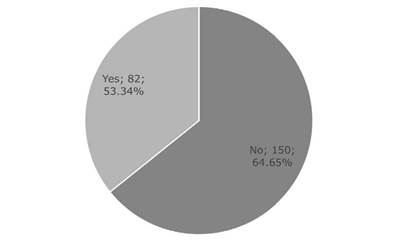
Source: Own elaboration.
Figure 1 Participation in formal networks of the research groups in medical and health sciences included in the study.
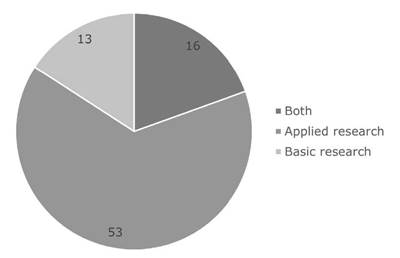
Source: Own elaboration.
Figure 2 Type of research performed by the medical and health science research groups that participated in the study. Source: Own elaboration.
Characteristics of researchers based on their participation in research networks
Significant differences were observed between researchers involved in networking and those who were not regarding the development of innovation products (p<0.01) and appearance in publication rankings (p=0.02) (Table 1).
Geographic proximity
Although the networks exist in a virtual space, it is clear that the physical distribution of researchers is influenced by economic and commercial activity, as they are concentrated in locations where these activities are more prevalent. Thus, the most economically powerful regions are also the most powerful in terms of research and networking, which helps them maintain and even improve their economic position. In this regard, two significant examples are provided below:
First, it was found that Antioquia has 122 officially recognized medical and health science research groups, which accounts for 17.08% of the 714 groups in the country; of these, 11 participate in networks. When comparing these groups with the national population volume, it was found that they equal 107.22% in relation to that population, and when analyzing this information and looking at it from an economic perspective, it was established that the GDP of this region alone was equivalent to 14.66% of the country's GPD for 2015.
Secondly, in the central region of Bogotá, it was established that there are 319 officially recognized medical and health science research groups, which accounts for 44.67% of the total number of groups in the country; of these, 25 are active in networks. When comparing these groups with Colombia's total population, it was found that they account for 229.43% in relation to said population, and when analyzing this information, it was established that the percentage of GDP of the region was 26.91% with respect to the whole country for 2015, a very high percentage compared to other regions.
Affective and physical proximity: comparison of results
Affective and physical proximity were assessed based on the results of the second survey. To this end, the responses from representatives of groups that participated in networks and those that did not were considered to determine whether it is necessary to be part of a formal network to improve the results of collaboration, as this sample allowed for a comparison of both types of groups and their results.
As mentioned above, only 37 of the 232 researchers responded to the second survey, with 29 citing the relevance of interaction and stating that even though it is not essential, it does inspire confidence; therefore, they also use virtual communication systems. Furthermore, of these 37 researchers, 17 stated that they were also able to achieve results through informal contacts, while out of the remaining 20, 8 said they were unable to achieve results in knowledge and research through informal contacts.
Both non-networking and networking groups had concrete results in terms of publications and participation in meetings. Similarly, groups that participate in networks produce more results, with the exception of publishing, which is more related to interactions with informal contacts.
Cognitive proximity
This concept focuses on a country's knowledge or innovation absorptive capacity that is useful to itself; in this sense, it is understood that networks should be used to collect transferable knowledge. The following are some of the indicators associated with the absorptive capacity of countries:
The first indicator is R&D expenditure with respect to the GDP, which in Colombia was 0.27% in 2016 according to World Bank.38 In countries like South Korea this percentage reaches 4.23%,38 making it one of the most important nations in terms of innovation and knowledge results.
The second indicator is the number of researchers per million inhabitants, which is 57 in Colombia. This figure contrasts dramatically with South Korea, where there are 6 856 researchers for every million inhabitants, a figure that is even more striking when one considers that South Korea has a far smaller population than Colombia.39
The third and final indicator presented by Ríos-Flores et al.40 relates to knowledge absorptive capacity associated with different factors. It has the objective of estimating the effect of technological capabilities on economic growth by differentiating between high- and low-income countries, adjusted for their absorptive capacities in a non-linear function. According to their study, Colombia is a country that is classified as a lower-middle income country and has a knowledge absorptive capacity of 0.3864, which is low compared to the world average of 0.6014, with the highest values being those of Ireland (1.25), Belgium (0.97), and the Netherlands (0.81).40
It should be noted that Rios-Flores et al.40 used 3 parameters to calculate knowledge absorptive capacity: GDP per worker, increase in R&D expenditure per worker, and technological capacity per worker. According to the results, the authors concluded that more work in this area is necessary, as has been done in other countries such as Chile, where the knowledge absorptive capacity is 0.59.40
Operational relations and results: network coherence
To identify the factors that contribute to network operation, a factor analysis was performed with 17 questions from the first survey, which aimed at assessing success factors.11 Each question was posed considering 5 possible levels of agreement, with 1 being no agreement and 5 being complete agreement.
The usefulness and suitability of factor analysis is established by means of the Kaiser-Meyer-Olkin (KMO) test and Bartlett's sphericity test, for which a value >0.5 and <0.05, respectively (significance level 5%), indicate that such an analysis can be performed. The results obtained with these tests for the instrument used in the present study were 0.88361 and <0.05, respectively, so it was determined that the factor analysis could be continued.41 Then, the KMO test established that the number of factors to extract was 3.
These three essential factors identified for the proper functioning of the network were called by the R statistical software according to the relationship with the grouping of results with the following concepts: MR1: "Strategy," MR3: "Consensus" and MR2: "Funding", thus summarizing the essence of the factors most associated with each of them (Table 2).
Multivariate analysis using logistic regression on obtained results
The results of the factor analysis were combined with the responses on the actual results of network participation from the first survey, and it was found that "cohesion of the scientific community", "identifying priority and collaborative lines", "publications" and "books" were significantly associated with the factor "strategy" (Table 3).
Discussion
The distribution and acquisition of knowledge through research networks nodes is an efficient, quick, and low-cost method of acquiring new knowledge and achieving optimal results in research and innovation.31
The present study demonstrated how network participation enables researchers to gain knowledge different from that obtained through national sources, with this knowledge being scientific analytical in most cases (95.12%).36 However, while virtual interaction was found to be relevant and effective in knowledge appropriation and generation, physical proximity and cognitive proximity were also found to be important in these processes.
In this sense, it has been reported that there is knowledge that requires physical interaction in order to be gained more quickly and effectively, because it is possible to know more than one can express in many cases;42 for example, face-to-face contact is very important in tacit knowledge.37 Therefore, even though much knowledge is preserved, an aspect such as the mobility of scientists would be key to network collaboration.43 In the same vein, and based on the findings of the second survey, the researchers emphasized on the need of physically knowing each other, as it would increase confidence when collaborating. This would confirm that physical interaction with people who are not members of their families or close friends (weak ties) is an important support for collaboration in networks among researchers.44
Another aspect of proximity identified in the present study and confirmed by other authors45,46 regarding network dynamics is that geographical location influences research activity because it relates to the economic competition of the regions. As for cognitive proximity, it was found that Colombia falls far short of several relevant indicators when it comes to promoting innovation and absorbing knowledge to build new innovations. Thus, according to Rios-Flores et al.40 Colombia had an average knowledge absorptive capacity indicator of 0.3864 between 2000 and 2010, a very low figure when compared to the value for innovating countries, which is approximately 1. This is critical because, as Saxenian points out,47 countries focused on innovation in global networks can project their economies.
A nation's capacity to absorb knowledge is built through the improvement of its basic education levels, its technological infrastructure,48 and its productive systems. In this sense, for knowledge transfer and innovation to be viable, academia must collaborate with businesses in a circular ecosystem to transfer information to the country's productive sources and build cumulative learning.49,50
In Latin America, several countries behave similarly to Colombia in terms of using knowledge networks. For example, according to the presentation of the Ibero-American Program of Science and Technology for Development (CYTED),51 between 2015 and 2018, more than 3 600 experts took part in the program's Academy-Business Forums, which are meetings between Ibero-American entrepreneurs and researchers that address specialized topics around a specific technology sector to promote innovation, transfer, and technological cooperation projects. During the same presentation, it was reported that over 5 000 researchers from 1 070 R&D groups and 180 companies from the 21 countries that signed the program participated in the 73 current actions of the program in 2018.
Similarly, from a corporate point of view, it is observed that innovation coming from emerging countries is driven mainly by contributions from foreign companies, which suggests that international links are a compensatory mechanism for the initially lower technological capabilities of some nations, rather than a complementary source of knowledge.52
It is important to highlight the factor analysis of network operation, in which the results stressed the need for a good strategy and a consensus-based participation model to achieve better results. In turn, funding is highly relevant, although, according to the findings of this study, it has no effect on concrete results or confidence relationships, which is consistent with what has been reported in the literature.11,17
With respect to concrete results, the factor analysis showed relationships between the network operation and the results, with an increase in the number of publications and in multidisciplinary work when the network functioned properly.
Based on the results of both surveys, it is possible to conclude that formal relationships are not required for joint publications, but they are quite useful for other products (advanced knowledge, patents, etc.). In this sense, it is necessary to ask whether these collaborations also contribute to novelty in the results, as some studies have found negative differences in novelty in international collaborations.53
The main limitation of the present study was that it was cross-sectional, therefore, no time sequences were performed to compare the results, thus new studies are necessary to analyze this aspect.
Conclusions
The results show that participation in knowledge and innovation networks in the medical and health area in Colombia is rather low, with just 36% of the researchers surveyed reporting involvement in these networks. Research carried out by the networks would be mostly applied with incremental innovation. Most researchers involved in these networks have more advanced training than those with specialties, namely master's and doctoral degrees, and they develop more innovation products and have higher academic production than those who do not.
There was also a strong association between, on the one hand, participation in research networks and the number of researchers and, on the other, economic capacity in the regions, which can be explained by the fact that economic growth and human talent are concentrated in prosperous regions.
The factor analysis of questions about network operation found that strategy, consensus, and funding are key elements. Thus, based on the logistic regression, it was determined that strategy and consensus are related to the achievement of actual results in publications and books, because the former influences scientific community cohesion and the latter has an impact on the achievement of multidisciplinary interaction spaces. By the same token, the recommendation is focused on working with tools to increase network consensus. Some examples of the application of these tools include the creation of practice communities, thematic workshops, shared learning platforms, among others. The challenge lies in identifying the models that facilitate the management of information and knowledge flow for all participants.
Finally, it is clear that knowledge and innovation networks are critical for generating more knowledge and research in the country; therefore, the competent authorities should promote the creation of new research networks and encourage researchers from the country's lagging regions to participate in them.
This work derives from the doctoral thesis entitled Factores asociados al éxito en el funcionamiento y participación de investigadores en Redes Científicas de Ciencias Médicas en Colombia (Factors associated with the successful operation and participation of researchers in Medical Science Scientific Networks in Colombia.)54














